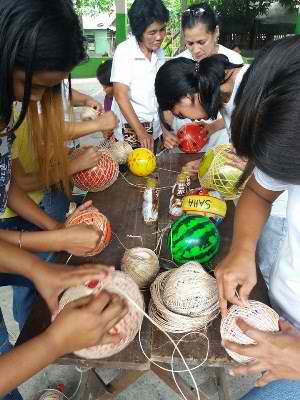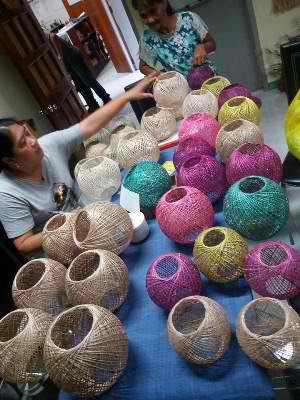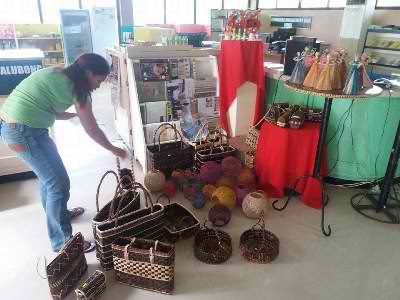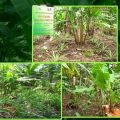Abaca fiber is one of the most high-valued commodities and products are grown in the Philippines due to its high demand both in local and foreign markets. The Philippines the world’s top and largest producer of abaca fiber and by-products. It is the strongest among the existing natural fibers and is primarily used as a raw material for pulp and paper, fiber craft, cordage, among others. With its wide range of uses, abaca has rapidly grown into an industry providing opportunities for livelihood and as additional income to abaca farmers and processors.

The Philippines Abaca Market Forecast and Opportunities reported that the abaca market is projected to grow at a compound annual growth rate (CAGR) of around 5.7 percent until 2019. Given this, there will be a continuous demand for abaca and its by-products for the future years thereby the need to increase production to cater to the local and international markets.
Fabricating abaca machine
The National Abaca Research Center (NARC) based at the Visayas State University (VSU), Baybay City in Leyte, one of the agencies mandated to uplift the abaca industry, has developed a multi-stranded yarning machine for the production of abaca yarn. This is to replace the tedious, time-consuming, and knotting method of tinagak-making. Support is being provided by the High Value Crops Development Program (HVCDP) and the Bureau of Agricultural Research (BAR) through its National Technology Commercialization Program (NTCP).

According to Dr. Feliciano G. Sinon, NARC-VSU project leader, in a traditional scenario, the conventional production of small twines for abaca handicraft is done by knotting individual fiber, combining the yarns, and twisting them into filaments to produce twine. This process is slow and labor intensive. Moreover, the traditional making of twine is a laborious work since the operator has to walk back and forth in setting the twisting end and in laying operation. Thus, NARC embarked on a project titled, “Development of a Twining Machine for the Production of 1-5 mm diameter Abaca Twine” that aimed to develop a twining machine for fast production of abaca twine from multi-stranded and untwisted abaca yarn and mainly to bring abaca machine generated technology to its adaptors and possible end-users.

Considered more economical than the traditional technique, the machine can produce 1.5 kg per day of multi-stranded yarn as compared to 1.0 kg of yarn per week using the knotting method. Twining capacity of the machine can produce good quality 1mm diameter twine at 200 m/hr, wherein the twine made from tinagak yarn using the machine was very smooth and has no protruding fiber ends.
Dr. Sinon pointed out that, the fabrication of the prototype twine machine was subjected to a series of different evaluation for its operational functionality. As a result, the machine has good acceptability ratings to end-users. Piloting activity of twining machine was tested, and many of the abaca handi-crafters in the community said that, “the twine machine is very useful for handicraft making, easy and simple to operate.” They also mentioned that the community could have one unit in the future, and end the manual twine making.
The cost and return analysis of the machine amounts to Php 45,000 with the net income of about Php 129/day with a payback period of 1.71 years and a return on investment as high as 58.35 percent.
Currently, two units of the machine were already sold to abaca cooperatives in Maharlika Abaca Growers Association of Magara, Roxas, Palawan and Sibugay, Zamboanga City for their handicraft production and expansion.
SAHA engages back into business

Seeing the importance of machine developed to the abaca processors and to other possible-end users, the project aimed to establish a village-level abaca yarn production and abaca by-products processing enterprises. This provides greater chances to strengthen the production capability of handicraft- abaca makers to engage in agribusiness using the developed machine. Thus, to further pursue this goal, the project “Pilot Production and Commercialization of Abaca Yarn, Twine, and its Derived Products in Region 8 Areas,” was implemented by NARC-VSU.
The San Agustin Abaca Handi-crafters Association (SAHA) in San Agustin, Babay City, Leyte, project collaborator of NARC-VSU, reorganized in 2015 capacitating their skills through training provided by NARC-VSU Team. Members of the association received learning skills on handicraft production, business-operational management, product marketing, and product development. The team also provided them technical assistance to develop both their leadership and organizational capabilities.
After the training in 2016, SAHA’s business operation started producing abaca yarns and processed abaca into new high-valued products. Aside from products made from “bacbac” like bags and coin purse, SAHA is now offering new products including twine balls, abaca decorative vases, macramé twine handbags, sinamay bags and other abaca derived products using abaca yarns and twines out of the generated machine.
To have a centralized area for SAHA’s business operation, a Handicraft Processing Center was also constructed by the project in the community. SAHA members are involved in all operational processes including purchasing of raw materials, making handicraft products, and delivery, among others. At present, four establishments in nearby locality of Baybay City, Leyte marketed their abaca products. These are: VSU Pasalubong Center; Baybay City Pasalubong Center; Laurente’s Store; and VSU-NARC Display Room.
SAHA also developed good business strategy wherein business operation and management scheme has been stabilized by the member to continue and enhance the production of their newly-developed products. Thus, the association provided the raw materials to the members and they in turn encouraged selling their products directly to the association where they are paid in cash. The percentage of the income goes to the association for additional budget for its continuous operation.
Sinon shared that the biggest benefit of the project was not only to provide abaca handi-crafters with additional knowledge on making abaca products for their income opportunities, but also to improve teaching capabilities by sharing their acquired knowledge through training. SAHA members continuously involved themselves from trainees to trainors, and recently they were tapped as resource persons in various handicraft trainings within Visayas and Mindanao. ### (Leoveliza C. Fontanil)
Source: http://www.bar.gov.ph/





